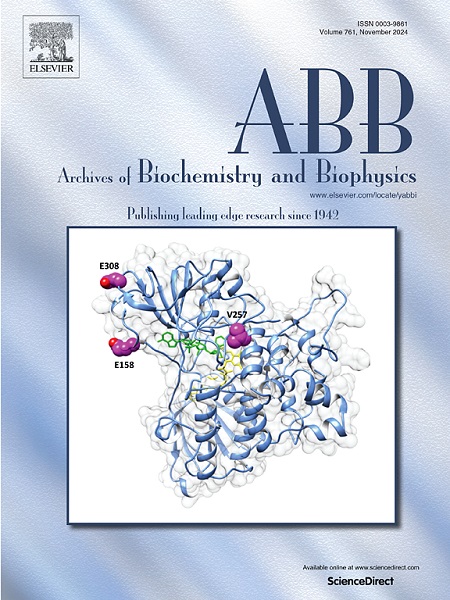分子动力学模拟揭示游离脂肪酸受体1 (FFAR1)的激活指纹和变构调节。
IF 3.8
3区 生物学
Q2 BIOCHEMISTRY & MOLECULAR BIOLOGY
引用次数: 0
摘要
游离脂肪酸受体1 (free fatty acid receptor 1, FFAR1)是一种跨膜g蛋白偶联受体,在胰腺细胞中介导内源性游离脂肪酸的代谢和胰岛素调节作用,同时在大脑中发挥神经调节作用。FFAR1的复杂性源于它的多个结合位点和在A类gpcr中观察到的常规激活基序的缺失。本研究使用分子动力学模拟来研究支持FFAR1内源性信号和变构调节的分子机制。我们研究并比较了三种配体结合态和APO态。配体结合的模拟包括:FFAR1与γ-亚麻酸配合物、FFAR1与γ-亚麻酸和TAK875配合物以及一个完全活化的FFAR1束与二十二碳六烯酸和g蛋白配合物。结果突出了相对于APO状态,配体结合状态下不同的蛋白质接触指纹和动力学。在没有稳定g蛋白的情况下,配体结合会破坏受体胞内结构域的稳定性,而第二个细胞外环则表现出更大的稳定性,并与跨膜结构域进行盐桥接触。值得注意的是,模拟FFAR1与γ-亚麻酸配合,结合在细胞内结构域,揭示了γ-亚麻酸与受体之间稳定的相互作用,以及与FFAR1与二十二碳六烯酸和Gq配合物相似的激活指纹。这表明在γ-亚麻酸与细胞内结构域结合后,受体的有效变构调节。最后,细胞内和细胞外区域的一组疏水氨基酸残基似乎起着潜在的旋转体开关的作用,促进水介导的受体激活。本文章由计算机程序翻译,如有差异,请以英文原文为准。
Activation fingerprints and allosteric modulation at the free fatty acid receptor 1 (FFAR1) revealed by molecular dynamics simulation
The free fatty acid receptor 1 (FFAR1) is a transmembrane G-protein coupled receptor that mediates the metabolic and insulinotropic effects of endogenous free fatty acids in pancreatic cells while also exerting neuro-regulatory effects in the brain. The complexity of FFAR1 derives from its multiple binding sites and the absence of conventional activation motifs observed in class A GPCRs. This study uses molecular dynamics simulations to investigate the molecular mechanisms that underpin endogenous signaling and allosteric regulation in the FFAR1. We investigated and compared three ligand-bound states and the APO state. The ligand-bound simulations included FFAR1 in complex with γ-linolenic acid, FFAR1 in complex with γ-linolenic acid and TAK875, and a fully activated FFAR1 bundle complexed with docosahexaenoic acid and G-protein. The results highlight distinct protein contact fingerprints and dynamics in the ligand-bound states relative to the APO state. While ligand binding, in the absence of stabilizing G-protein, destabilizes the intracellular domain of the receptor, the second extracellular loop exhibits greater stability and salt bridge contact with the transmembrane domain. Notably, simulations of FFAR1 complexed with γ-linolenic acid, bound at the intracellular domain, revealed stable interactions between γ-linolenic acid and the receptor, as well as similar activation fingerprints when compared to FFAR1 in complex with docosahexaenoic acid and Gq. This suggests an effective allosteric regulation of the receptor following γ-linolenic acid binding to the intracellular domain. Finally, a set of hydrophobic amino acid residues at the intracellular and extracellular domains appears to function as potential rotameric switches, facilitating water-mediated receptor activation.
求助全文
通过发布文献求助,成功后即可免费获取论文全文。
去求助
来源期刊

Archives of biochemistry and biophysics
生物-生化与分子生物学
CiteScore
7.40
自引率
0.00%
发文量
245
审稿时长
26 days
期刊介绍:
Archives of Biochemistry and Biophysics publishes quality original articles and reviews in the developing areas of biochemistry and biophysics.
Research Areas Include:
• Enzyme and protein structure, function, regulation. Folding, turnover, and post-translational processing
• Biological oxidations, free radical reactions, redox signaling, oxygenases, P450 reactions
• Signal transduction, receptors, membrane transport, intracellular signals. Cellular and integrated metabolism.
 求助内容:
求助内容: 应助结果提醒方式:
应助结果提醒方式:


